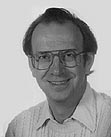|
Leonid MAC |
| home |
| View the shower |
| Mission Brief |
| Science Update |
| Media Brief |
| links |
 Dr. Hans Stenbaek-Nielsen,
Dr. Hans Stenbaek-Nielsen, Geophysical Institute, University of Alaska Fairbanks, Alaska, USA 
Last updated: October 2002
Brief Biographical Information:
Professor of Geophysics,
University of Alaska
Research: Professor Nielsen has a research background in auroral and magnetospheric physics. At the institute, he has worked mainly in auroral research. During the last 10 years, he has been engaged in chemical release experiements, notably the barium shaped-charge program and in auroral work. Professor Nielsen also is teaching graduate and undergraduate courses within the Department of Physics.
Sequence of high-speed imager data from a sprite event at 05:10:38.605 UT, 18 August 1999. Example of high-frame rate images of a sprite, a lightning phenomenon between clouds and upper atmosphere. The images show that the lightning starts around 74 km altitude and then develops both downward and upward. Research on Leonid MAC:
First attempt at high-frame rate imaging of meteors using a digital, low-light-level, 1000 frame per second intensified CCD imager developed by the Geophysical Institute, University of Alaska Fairbanks. The digital images are 256x256 pixels at 8 bit (256 gray levels) and the field of view is 6.4x6.4 degrees.ÿý The instrument responds to light at wavelengths 500-900 nm with maximum sensitivity at 700 nm.
During the 2001 Leonid MAC mission, a shock-like feature was discovered to exist around Leonids brighter than -2 magnitude. The shock emission was confirmed during the 2002 Leonid MAC Mission. More here.
|


